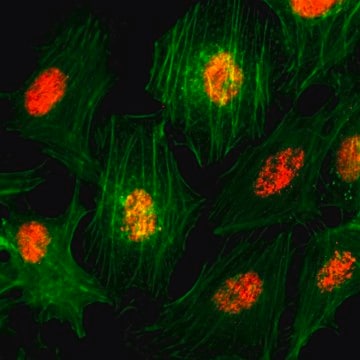MABT1499
Anti-MBP (Citrulline R122) Antibody, clone 1H1
clone 1H1, from mouse
Sinónimos:
Myelin basic protein, Myelin A1 protein, Myelin membrane encephalitogenic protein, Citrullinated MBP
About This Item
Productos recomendados
biological source
mouse
antibody form
purified immunoglobulin
antibody product type
primary antibodies
clone
1H1, monoclonal
species reactivity
mouse, human
packaging
antibody small pack of 25 μg
technique(s)
ELISA: suitable
immunohistochemistry: suitable
western blot: suitable
isotype
IgG1κ
NCBI accession no.
UniProt accession no.
target post-translational modification
citrullination (Arg122)
General description
Specificity
Immunogen
Application
Western Blotting Analysis: A representative lot detected MBP (Citrulline R122) in Western Blotting applications (Jang, B., et. al. (2018). Mol Neurobiol. 55(4):3172-3184).
Western Blotting Analysis: A 1:1,000 dilution from a representative lot detected MBP (Citrulline R122) in Myelin basic protein (MBP) treated with human PAD2 (Courtesy of Byungki Jang, Ph.D./Eun-Kyoung Choi, Ph.D., Ilsong Institute of Life Science, Hallym University, South Korea).
Immunohistochemistry Analysis: A representative lot detected MBP (Citrulline R122) in Immunohistochemistry applications (Jang, B., et. al. (2018). Mol Neurobiol. 55(4):3172-3184).
(Courtesy of Byungki Jang, Ph.D./Eun-Kyoung Choi, Ph.D., Industry Academic Cooperation Foundation, Hallym University, South Korea).
Cell Structure
Quality
Western Blotting Analysis: 1 µg/mL of this antibody detected MBP (Citrulline R122) in GST-tagged myelin basic protein (MBP) treated with human Peptidyl Arginine Deiminase 2 (PAD-2)(200 ng for 4 h at 37°C).
Target description
Physical form
Storage and Stability
Other Notes
Disclaimer
¿No encuentra el producto adecuado?
Pruebe nuestro Herramienta de selección de productos.
Certificados de análisis (COA)
Busque Certificados de análisis (COA) introduciendo el número de lote del producto. Los números de lote se encuentran en la etiqueta del producto después de las palabras «Lot» o «Batch»
¿Ya tiene este producto?
Encuentre la documentación para los productos que ha comprado recientemente en la Biblioteca de documentos.
Nuestro equipo de científicos tiene experiencia en todas las áreas de investigación: Ciencias de la vida, Ciencia de los materiales, Síntesis química, Cromatografía, Analítica y muchas otras.
Póngase en contacto con el Servicio técnico






